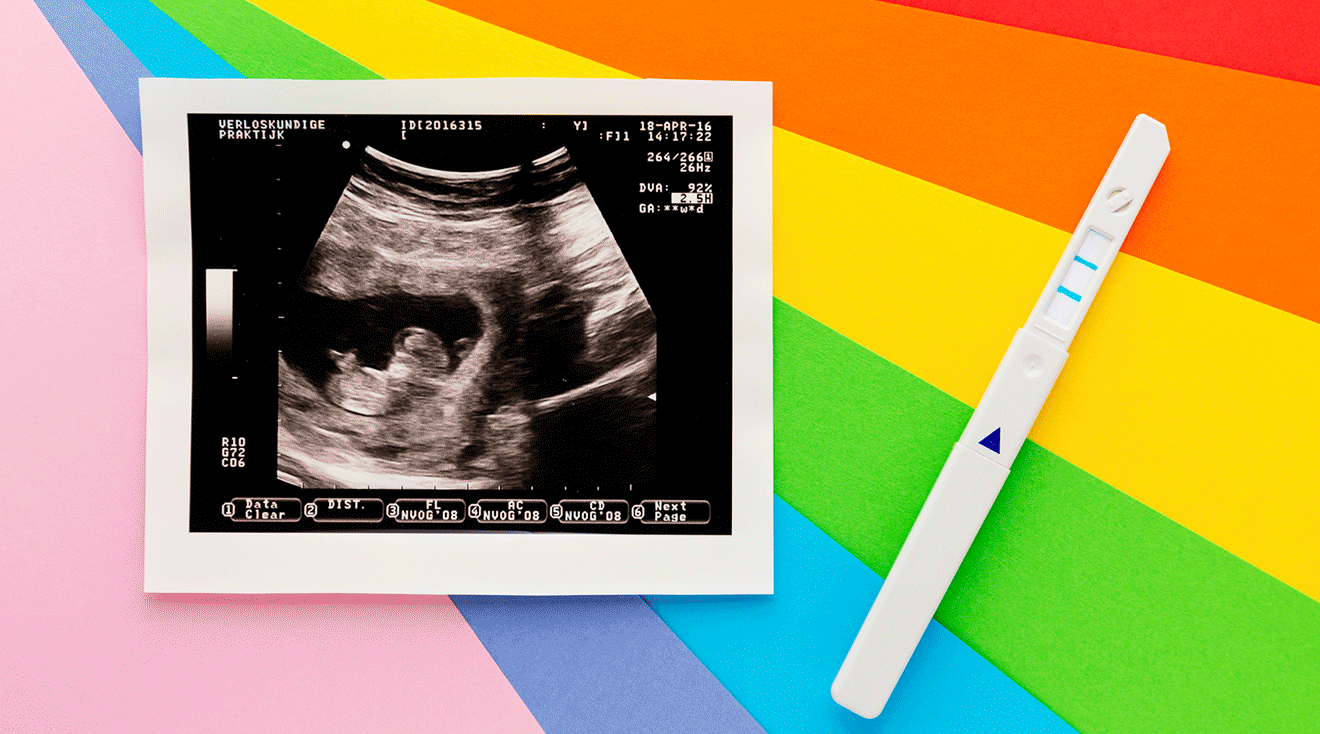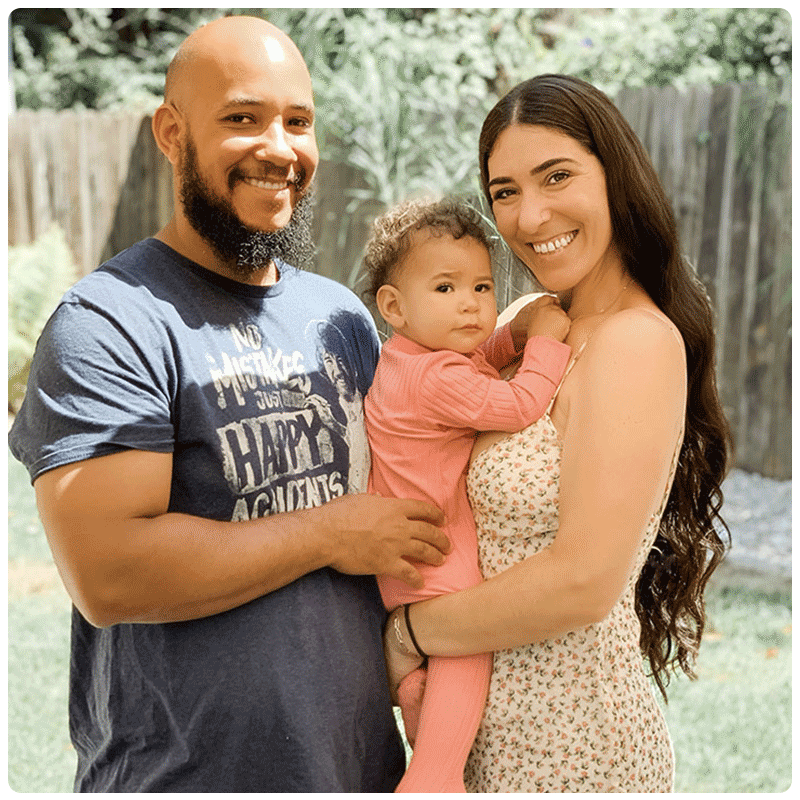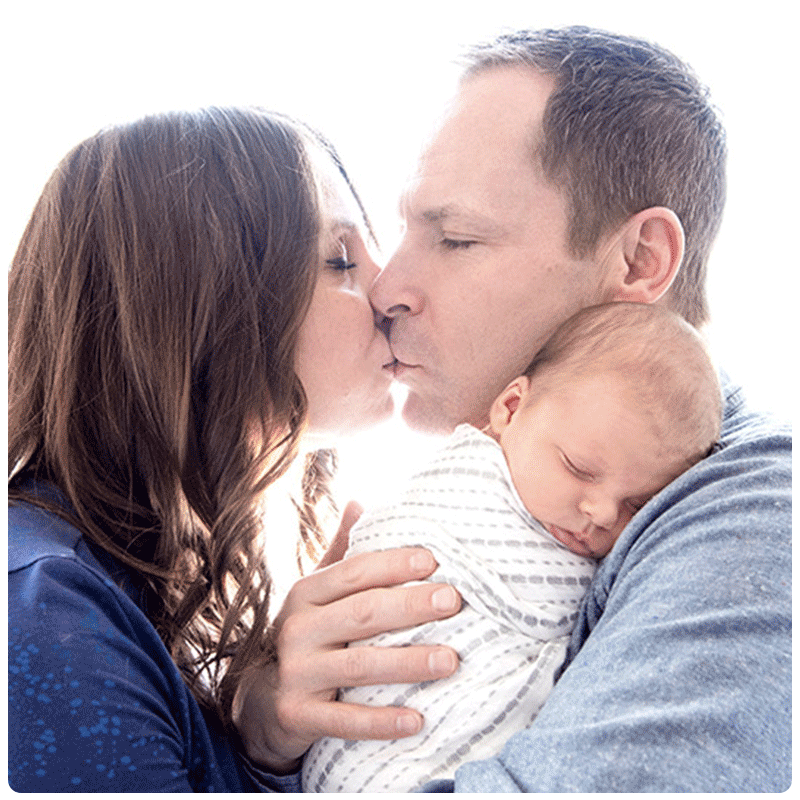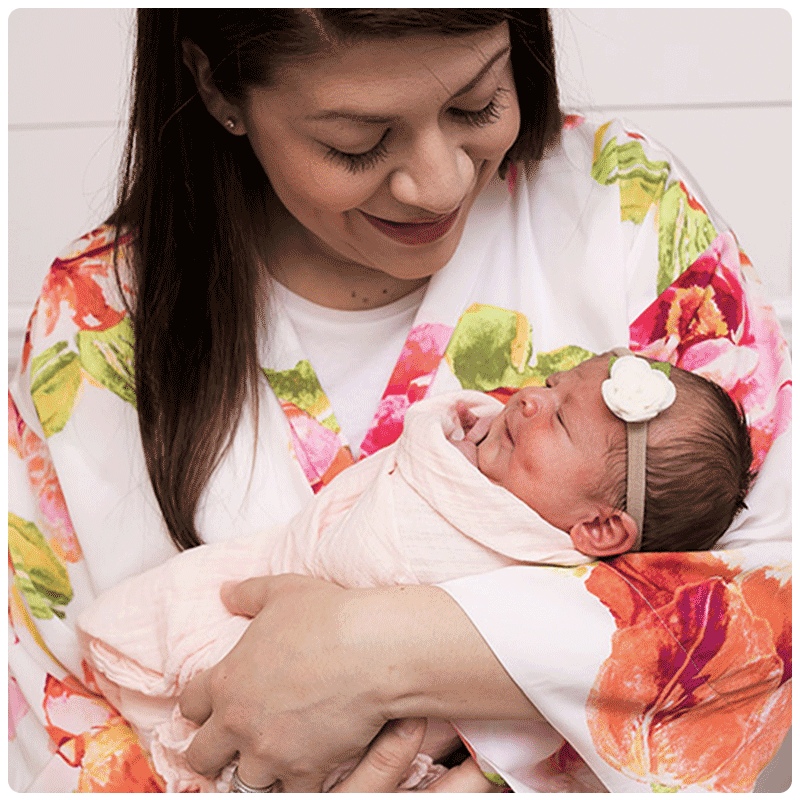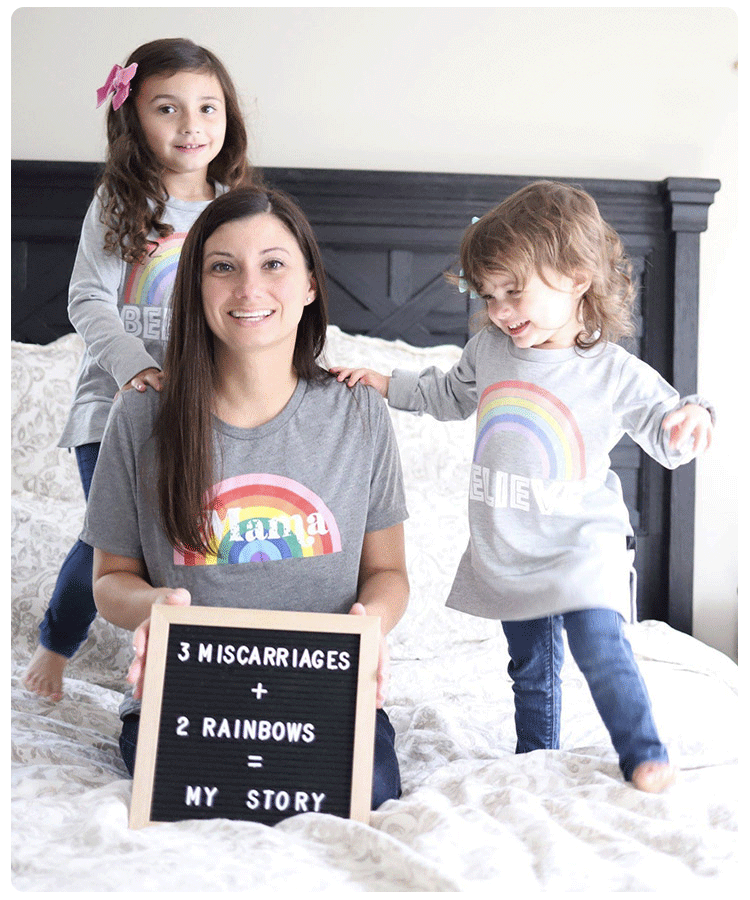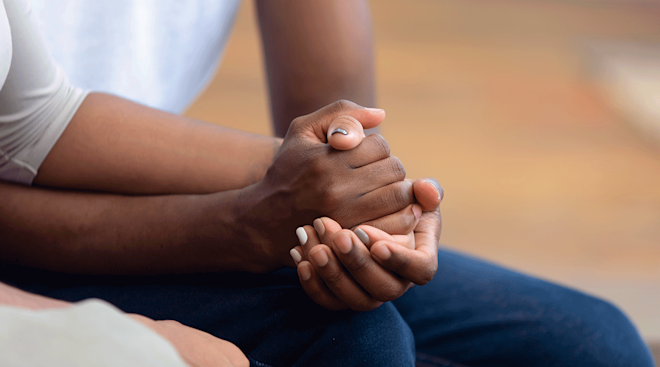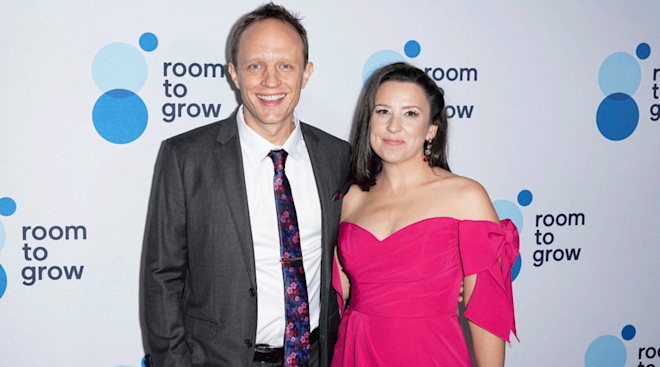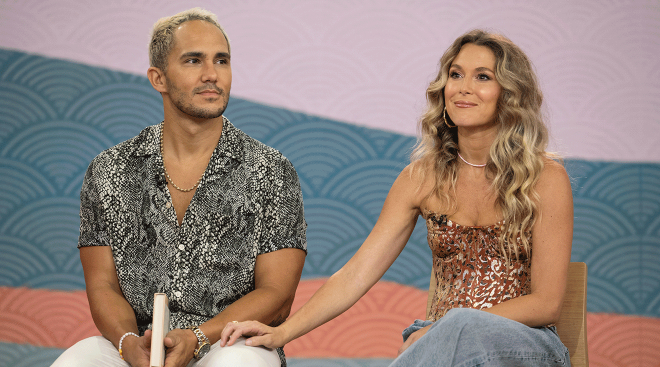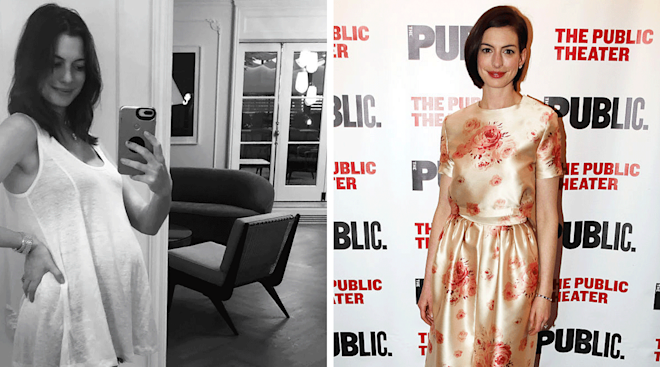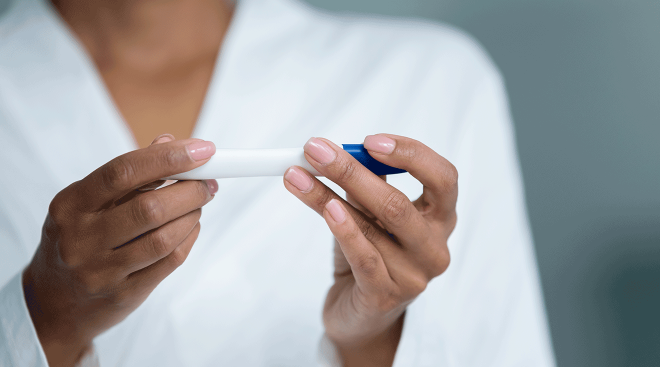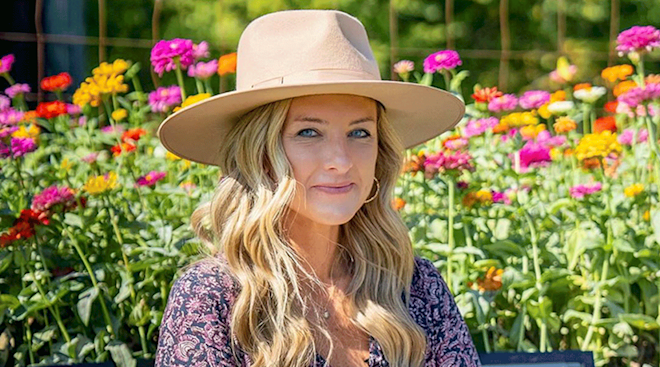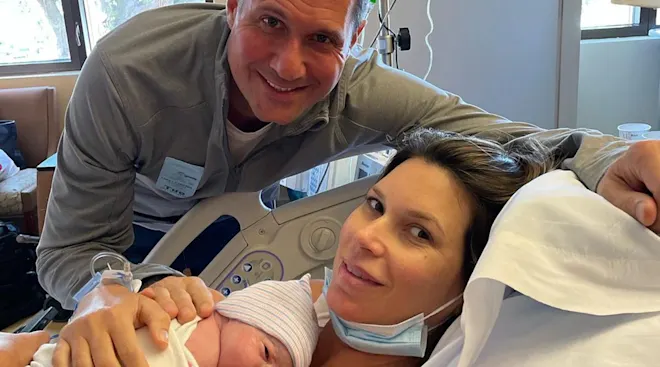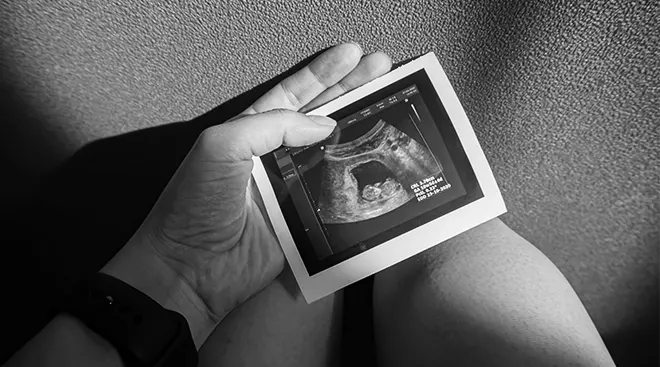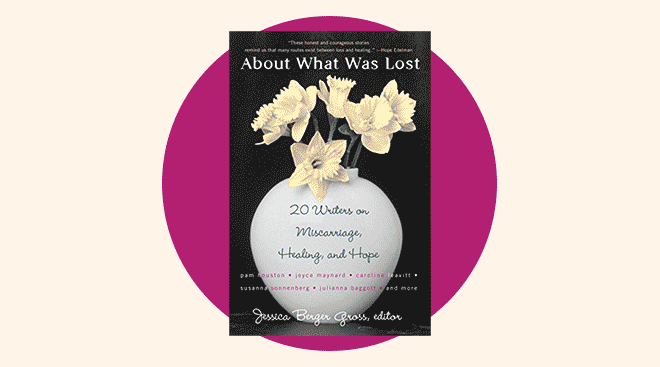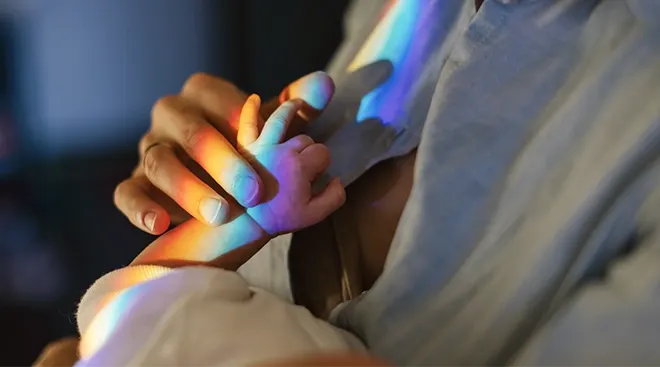What Is a Rainbow Baby?
Welcoming baby is undoubtedly an emotional journey to navigate. When you see that telltale second line on a pregnancy test, your whole life changes in the blink of an eye. Finding out you’re expecting a baby is an experience unlike any other. But with feelings of joy, hope and elation can come the fear of miscarriage, stillbirth or loss of the baby you’ve dreamed about so fervently—especially for families expecting a rainbow baby, who have experienced loss before.
According to the American Pregnancy Association (APA), 10 to 25 percent of pregnancies end in miscarriage. Needless to say, the mental and emotional aftermath can be devastating for parents. How do they endure through this pain and sadness? What happens when they try to have another baby after facing such a loss? And how can they cope if they do get pregnant with a rainbow baby? Here, we’re explaining the meaning of a rainbow baby and highlighting stories of real parents who have experienced the grief of losing a baby and the joy of welcoming a rainbow child.
If you’ve never heard the meaningful expression, you may be wondering: What is a rainbow baby? A rainbow baby describes a child born after the loss of a previous baby due to miscarriage, stillbirth or death in infancy, says Jillian Thistel, a certified perinatal mental health clinician and pediatric sleep specialist. “A rainbow is used because it’s symbolic of the beauty after the storm (and the grief),” adds Renée L. Goff, PsyD, PMH-C, a licensed clinical psychologist certified in perinatal mental health. A rainbow baby can also refer to a newly adopted child. This symbolic term gives us hope of what’s to come, and, likewise, rainbow babies usher in love and light after a period of darkness.
Rainbow babies are undoubtedly special, but they’re actually not all that uncommon. According to the APA, 85 percent of people who experience pregnancy loss will go on to have a successful pregnancy. “It’s hard to know an exact number of rainbow babies being born, as miscarriages and infant loss may be underreported (or may not be talked about openly), but it’s important for families to note the statistics that many women will go on to deliver a rainbow baby following loss,” Thistel says.
It’s important to note that the term “rainbow baby” may not feel right for all families—and that’s okay. “Grieving the loss of a child is a difficult journey full of different emotions, and it’s important to use language and terms that resonate with you,” Thistel adds.
What is a double rainbow baby?
Goff notes that a double rainbow baby is a baby born following two pregnancy or infant losses. According to the APA, 75 percent of people who have experienced two or more pregnancy losses go on to have a successful pregnancy.
Having a rainbow baby after losing a previous child brings a broad range of emotions, and many expectant parents will tell you that these feelings are not all positive. Some mothers who’ve weathered loss and gone on to have another baby feel a tremendous sense of self-doubt and guilt. They fear others will think they’ve gotten over their loss, or that they’ve moved on and replaced their baby. They worry that having a rainbow baby in some way dishonors their baby who has passed, and that the joy of welcoming another child will prevent them from properly grieving. It’s a lot to juggle and work through, and there’s no guidebook to follow. “Take a self-compassionate stance regarding these mixed emotions, knowing that your body and brain are trying to process your loss and your upcoming birth,” says Aparna Iyer, MD, a reproductive psychiatrist in Frisco, Texas.
Below, experts offer some ways to cope with all the conflicting emotions. “These same tips can be used during the postpartum period, and into parenthood as well,” Thistel adds. “Entering into parenthood is a big shift in itself, and a lot of energy goes into taking care of someone else.”
Know your feelings are all valid
Some parents going through the experience have heightened anxiety and worry that something could go wrong. “Doctor visits and ultrasounds can be very anxiety-provoking this time around, which may feel foreign if these appointments felt exciting in the previous pregnancy,” says Iyer. In fact, many parents expecting their rainbow baby may find it difficult to relax until they’re holding baby in their arms. It’s okay to feel all of these emotions, but it’s important to acknowledge and process them. “Trying to push these feelings and emotions aside isn’t helpful and only adds more stress and pressure on you,” Goff says. But perhaps the most important part of acknowledging your emotions is doing so without judgement and giving yourself enough time and space to process. As Thistel notes, “Remember that some days may feel harder than others, and your healing process is unique.”
Embrace any shifts in perspective
Being pregnant with a rainbow baby may introduce an unexpected shift in perspective. Some women find a renewed appreciation for the otherwise not-so-pleasant parts of pregnancy. Mild morning sickness, for example, may suddenly feel like a reassuring comfort. Moreover, other rainbow moms find themselves slowing down to soak up the little moments and milestones—a belly kick from a rainbow baby might feel extra meaningful.
On the other hand, some of the milestones you encounter with your rainbow baby may feel bittersweet. “Each milestone, holiday, and birthday may be a constant holding of conflicting feelings,” Goff says. “Remind yourself it’s absolutely okay to have conflicting feelings. Feelings are not mutually exclusive. There’s no need to try to talk yourself out of it.”
Incorporate self-care into your routine
Self-care doesn’t have to just mean enjoying a massage or pedicure—it “can be as simple as finding 10 to 15 minutes per day to do something that feels good to you,” Thistel says. Taking some off the stress off self-care practices may make them more attainable. These activities can include reading a book, listening to music or a podcast, enjoying a cup of coffee or tea, going for a walk, calling a loved one, meditating or journaling to process and let go of any emotions. “The most important thing when it comes to self-care is really tapping into what works best for you,” Thistel adds.
Find a strong support system
Surround yourself with family, friends, colleagues and other supportive people you can lean on during this time—and these include professional support systems and individuals such as doctors and therapists. There are also many support groups available to parents expecting rainbow babies, which can help you process what happened, honor your path and connect with others who’ve had similar experiences. “Carrying this yourself is a lot to manage and emotionally exhausting,” Goff says. If you’re experiencing pervasive sadness or depression, talk to your doctor, and if you’re having thoughts of self harm, seek immediate help.
One of the hardest parts about suffering a loss is that often those we turn to for support may not know what to say and how to be there. “Remember that you don’t always have to think of the ‘perfect’ thing to say,” Thistel says. “Simply being there for someone and letting them know you care, you’re thinking of them and that you’re there to support them can go a very long way.” Below, she and Goff list some ways loved ones can offer support to parents expecting their rainbow baby.
- Checking in: Ask how the expectant parents are feeling and see if there’s anything you can do to help. While it’s important to support the birthing parent, be sure to also offer support to non-birthing parent during the rainbow pregnancy (and afterwards) too. “Some days may be great, while others extremely difficult. Let them know you’re ready to listen or just sit with them regardless of what kind of day it is for them,” Goff says.
- Validating their experiences: Avoiding putting pressure on them to act or feel a certain way. Instead, give them space to process their feelings and experiences in whatever way feels best for them—and absolutely avoid making “at least” comments. “For example, when someone is expecting a rainbow baby or has one and they’re talking about the baby they lost, avoid saying ‘at least you were able to get pregnant again…at least you have another baby now,’” Goff explains. “[These] comments minimize their experience and can make it feel like their baby didn’t matter, didn’t exist or that they ‘should have moved on already.’”
- Don’t be afraid to talk about it: “Many people who are expecting a rainbow baby appreciate it when others talk about the baby they lost by name, whether in conversation or in writing or when gift giving,” Goff says. While it may be a little uncomfortable at first, respectfully acknowledging the parents’ loss and their hardship can be incredibly validating.
Like coping with conflicting emotions, it can be hard to honor a loss while celebrating new life. For Alexis DelChiaro, founder of What the Fertility, the solution was creating National Rainbow Baby Day in 2018, which is celebrated annually on August 22. “It’s important to remember that each family will honor their loss in different ways, and celebrate their pregnancy in different ways,” Thistel says. “There isn’t one specific way that’ll work well for each family—it’s important to do what feels right to you.” Below, she and Goff offer ways parents can honor their loss and celebrate their rainbow baby:
- Taking part in rituals: Some families may wish to do this privately, while some may have more public rituals, Goff says. But some ideas could be making a memorial in a special place in your home, lighting candles or releasing a lantern on what would have been your baby’s due date or birthday, taking a walk at a sentimental place or simply speaking about the experience with loved ones. All of these things allow parents the space to grieve their loss, Thistel notes.
- Make memories: Another way to honor what would have been baby’s birthday is to drop off care packages or donations at a local hospital or shelter, Goff says, adding that you can even bring your rainbow baby with you to start a new family tradition. You can also get an item, like a piece of jewelry or holiday ornament, that commemorates both the child you lost and your rainbow baby. If you happen to have pictures of baby, you can have a few framed and place them around the house where you’ll be able to see them regularly. “There are also some incredibly beautiful books that can be personalized to the rainbow baby about the sibling that came before them,” Goff says. “It’s a way for parents to honor the baby they lost and continue to keep this baby’s memory alive while sharing it with their sibling.”
- Celebrate your rainbow baby: Define this celebration of life any way you want. It could be in the form of a social media rainbow baby announcement that honors both children, a birth announcement or a rainbow baby shower—and, while all of these can include rainbow themes, they don’t have to. “Some parents may also choose to keep their birth announcement for close friends and family members until they’re feeling comfortable with sharing the news later on in the pregnancy,” Thistel says. If parents do want to throw a rainbow baby shower, if they already have the items you want and need, they can request donations be made to organizations supporting those who’ve experienced loss instead, Goff adds.
“Ultimately, [parents] should do what feels best to them. Lean into it. Don’t allow your thoughts about what others might say or are saying keep you from doing what you want,” Goff says. “It’s your baby. Honor and include them in whatever way feels comforting.” A rainbow baby doesn’t mean your loss will be forgotten. Rather, your rainbow baby will carry the torch of the love you’ll always have for the child you lost—and when you hold that precious rainbow baby in your arms, you’ll finally fully understand the meaning of this transformative term.
Nothing can better describe the experience of having a rainbow baby than hearing directly from rainbow moms themselves. These incredible rainbow baby stories are bittersweet and triumphant tales of renewal and healing.
Jessica Kunen’s rainbow baby story
Four months after getting engaged, Jessica Kunen and her fiance knew they were ready to start trying for a baby. “We decided to take a pregnancy test on the morning of June 4, our nine year anniversary of being together,” Kunen recalls. And when they saw the positive line appear? “We were completely shocked and excited.” Sadly, their elation was fleeting. A few weeks later, when the couple went for their first ultrasound, they were heartbroken to see that Kunen’s uterus was empty. “There was nothing there; it was like a blank black hole on the screen, and our hearts dropped,” she says. Understandably, they were confused when the doctor told them it was an ectopic pregnancy. Kunen shares, “I naively thought, ‘Okay, well, let’s just move it from my fallopian tube into my uterus. That’s a thing, right?’” (Unfortunately, it’s not.)
Suffice to say, it was a lot for Kunen to handle. “The wave of emotions were so fast; my body and mind were not equipped to process trauma like that so quickly.” Nevertheless, Kunen put on a brave face to take care of business. She immediately went for bloodwork to check her hormone levels and found out she’d need emergency shots of Methotrexate to stop the ectopic pregnancy. A few days later she began bleeding heavily, and the trauma didn’t stop—Jessica’s stomach became distended and she could barely walk. She learned that she had developed a very large blood clot between her uterus and bladder; it eventually passed on its own, but not without causing immense pain. What’s more, the physical toll ushered in even more mental anguish. “My mind hit every dark corner of depression that I hadn’t seen in over a decade. I was like, ‘Okay, I live here now. This is me,’” Kunen says.
Fortunately, her doctor was a beacon of support. She encouraged them to try again after one menstrual cycle, but Kunen needed a bit more time to heal emotionally. “I listened to my intuition and we tried again in October—and our rainbow miracle pregnancy happened,” she says. They went for an ultrasound at 6 weeks and were able to see the heartbeat. Kunen describes the moment as “absolute magic.” On July 18, she labored and delivered at home in her bed. It was exactly what she wanted for her experience. “As soon as she came out, my husband said she looked like Winnie the Pooh,” Kunen remembers. They hadn’t settled on a name quite yet, but, after days of “soaking up her sweetness… It just stuck.” Winnie Oliva instantly became the great joy in her mom’s life. “Sometimes you just need a ‘win’ in life—and she is it,” Kunen says.
Heather Hesington’s rainbow baby story
“I’ve had a variety of jobs that include everything from being a professional dancer for the National Basketball Association to a personal trainer, but more than anything, I always knew I wanted to be a mother,” Heather Hesington tells The Bump. But due to multiple job layoffs and two cross-country moves, she and her husband put off growing their family until three and a half years into their marriage—and by then, they were more than ready to bring a baby into the world. That excitement turned to frustration after several months of trying without success. Months turned into a year—but then Hesington finally got to live her dream of telling her husband they were expecting.
“Everything went great at our 8-week ultrasound, and we showed the blurry collection of photos to our families on Christmas Day,” she says. “I knew things weren’t going as planned, however, the day before our 12-week ultrasound appointment. After some concerning spotting, my husband and I returned to the same ultrasound room that made us cry happy tears, only this time we left without that amazing sound of a heartbeat.”
Their doctor thought they lost the baby around 9 weeks, and Hesington’s body experienced what’s labeled as a missed miscarriage. “We scheduled a D&C for the next day, and that was one of the hardest days of my life,” she says. “The nurses who walked me through the procedure were encouraging and shared their own stories about their miscarriages and how they both got pregnant again shortly after. This gave me a lot of hope, but this loss affected me more than I ever imagined it could, and I still grieve the loss of our first baby to this day.”
After another full year of trying to get pregnant, Hesington saw a positive pregnancy test and was over the moon. She told her husband right away, and he insisted on telling their closest friends and family. “I was very open about our journey in trying to conceive as well as our first loss on my blog,” she says. “I went against the normal trend of hiding feelings and the not-so-perfect times on the internet. Doing so was not only therapeutic for me, but it also enabled many others to share their own stories and talk about their losses too.”
Hesington and her husband decided to get holiday pictures taken in early November, and since she was already 7 weeks along, they shot a few pregnancy announcement photos too. They went in for the 8-week ultrasound the next week, but left with scans showing a pregnancy sac without a baby. “Just to be sure I wasn’t just measuring behind, we came back the following week for another ultrasound, and there was the tiniest flicker of a heartbeat. We had hope!” she says. “Sadly, at 10 weeks, our baby had disappeared again, and this loss hit me just as hard as the first one.”
Hesington says the hardest part of going through miscarriages is the envy you naturally develop toward others who seem to effortlessly get pregnant. “During our years of trying, it felt like pregnancy announcements and baby milestones filled my news feeds just to haunt me,” she says. “I was happy for my new mommy friends, but I also kept my distance from them when I was going through a rough patch. In fact, I wrote an open letter about this, as well as the pregnancy envy I was struggling with.”
It took some time, ample rest and a lot of support from friends and family, but Hesington and her husband decided to start trying again a few months after their second loss. Just in time for their six-year wedding anniversary and just shy of three years after first trying to conceive, Hesington learned she was pregnant and wrapped the tests up like a present to gift her husband in order to share the news. After experiencing multiple miscarriages, it was a time to celebrate, but they were also extremely nervous. She wound up having a scare early on at about 5 weeks and thought she was going to have another miscarriage, she says. She was shocked when the ultrasounds came out totally normal.
Hesington continued on to have a healthy, full-term pregnancy but was nervous throughout the entire journey. “I was more than careful about what I ate and drank (or didn’t), and I modified my exercise level down to a much easier routine,” she says. “I remember it being a struggle to have joy and grief co-exist, but I learned that it can and does in my life, even today.” Their beautiful rainbow baby, Skyler King, is a reminder of this truth. “I fall more in love with him every single day, and he’s completely perfect in my eyes,” Hesington says.
“While there are definitely challenging moments of being a parent, I truly believe that everything we went through to finally have him was 100 percent worth it,” she adds. “I think the journey helps with the harder and lonelier days too. Going through three years of endless tears, prayers and heartbreaks wasn’t easy, but that time is what shaped me to be the mother I am to him today. I don’t take any time with him for granted, and I still think about those struggling through infertility and miscarriages often.”
Felicity’s rainbow baby story
Two years ago, Felicity and her husband were ready to have a baby; she assumed she’d get pregnant fast and everything would be perfect. After all, things were already pretty perfect: She was married to her high school sweetheart, they had just returned from an awesome vacation to Mexico, they had great jobs, a beautiful home and two dogs.
Sure enough, Felicity became pregnant easily. She and her husband waited until they were in the “safe zone” at 16 weeks and announced the pregnancy on Thanksgiving. But soon after, Felicity began experiencing some spotting; she woke up one morning with severe cramping and blood clots. “I remember sitting in the car in silence as we sped to the hospital,” she says. “My body succeeded at creating a miracle of life, but now my body was failing me and rejecting what it created. I couldn’t really process what was happening.” She walked numbly into the emergency room and shortly after miscarried in the hallway.
“The feeling that comes with a miscarriage is unlike anything I’ve ever felt,” Felicity says. “I felt guilty, like I had done something wrong. The feeling was deep, like part of myself had died. I didn’t understand my own feelings, and I didn’t know how to explain it, even to my husband.” She went back to work the following Monday and felt like everyone was staring at her. She put a smile on her face and pretended everything was okay—but when it proved too much, she found a closet and burst into tears. What made it worse was that no one seemed to know what to say to her. She admits she didn’t even know what she wanted or needed to hear. She dreaded going to work and just wanted to stay home, to lie in bed and never leave.
But after the new year, Felicity and her husband began trying again. In the spring, they had a moment of joy when they found out they were pregnant again. Sadly, the moment was short-lived, and she miscarried at 8 weeks.
She remembers lying in the doctor’s office looking at the screen as the ultrasound showed blank emptiness, as if they were looking into her heart, she says. This time Felicity and her husband kept the loss secret (telling only their parents), which proved painful and burdensome to hide. “I reached the lowest low that I’ve felt in my life,” she says. “The ‘what-ifs’ began to go through my mind that summer as I reached what would have been my due date with my first baby. What would my baby have looked like? Would it have been a boy or a girl?” Felicity began taking medication in hopes of getting pregnant and having a healthy pregnancy. She also discovered a ministry group called Waiting in Hope that supports women as they navigate infertility, loss, miscarriage and adoption. It was just what her soul needed, she says. “At the time I didn’t realize, but looking back, my miscarriages had taken a toll on me, not only physically but also mentally. I met women that knew exactly what it was like to struggle with conceiving. I wasn’t alone on this journey. They brought hope, encouragement and strength during this difficult time.”
She found herself living month to month, taking countless ovulation tests and pregnancy tests in hopes of a positive result, but each time saw a screen staring back with the verdict “not pregnant.” Felicity scheduled an ob-gyn visit to discuss her options, but couldn’t help wondering if having a baby just wasn’t in the cards. “This was difficult for me to grasp,” she says. But a few days before her doctor visit, she felt sick to her stomach, light headed and dizzy. “Any other month I would have taken a pregnancy test,” Felicity says. “Instead, I told myself I was going to wait until my doctor’s appointment. But the day before my visit, I couldn’t wait any longer. I took a pregnancy test and ‘pregnant’ flashed on the screen.” She was shocked, as were the doctor and nurses when she explained that her infertility appointment would now need to be a pregnancy appointment. For the first time, they saw the little flicker of a heartbeat on the screen.
Deciding when to announce the pregnancy was confusing. “I wanted to announce right away, since if we suffered another loss, I’d want the support of my friends and family,” Felicity says. “But other days I wanted to wait until we were halfway through the pregnancy, or maybe just skip everything and go straight to the birth announcement!”
The road from that point on was hard. She found it difficult to feel any excitement. “I was robbing myself of the joy I wanted to feel through my pregnancy,” she says. “I was afraid to buy baby things, and I didn’t want to decorate the nursery. My husband was the one who started a baby registry and I got an email invite to join.” She made it past 16 weeks, the point when Felicity experienced her first loss, but her anxiety remained at an all-time high. She found herself holding her breath at every doctor’s visit as they checked baby’s heartbeat.
On the last day of July, Felicity and her husband finally held their rainbow baby Emma Rose in their arms. “She was perfect. She was alive,” Felicity says. “There are moments now when I’m up breastfeeding our daughter and she’s peacefully sleeping in my arms that my tears will roll onto her soft forehead. I found joy again; I laughed again after I thought I never would. The happiness she has brought is indescribable.”
“Though I was never able to hold my two other babies in my arms, I was always a mother,” she says. “I have two in heaven waiting and one here on earth. I wouldn’t trade them for the world. We have weathered the worst storm of all and came out on the other side. It taught me to cherish everything because it can be taken away at any second.”
Cheryl Heitzman’s rainbow baby story
When Cheryl Heitzman learned she was pregnant with her first baby, she had a tough time getting excited. The pregnancy was unexpected, and due to some mental health struggles, she wasn’t sure she was quite ready to be a mother. But she took comfort in the depth of her husband Ben’s enthusiasm, and she tried to put her worries aside. “At our first ultrasound, I wasn’t exactly sure what to expect, but I knew enough to recognize that there was no heartbeat,” she says. “My heart sank, and when I looked over at Ben, with a big smile still all over his face, it completely shattered.”
Many years later, armed with a new doctor and medications that made her feel whole and healthy again, Heitzman decided she felt strong enough, physically and mentally, to try for their rainbow baby. Her husband was ecstatic, but she was worried, as so many rainbow moms are when they begin this journey. Nevertheless, she got pregnant quickly; within four months she and Ben were expecting their rainbow baby. At first, Cheryl’s severe first trimester morning sickness did little to quell her fear of miscarriage. But as the weeks went by and she hit the 12-week mark, she began to slowly relax. She felt baby’s first flutterings right at 16 weeks, and says, “Maybe he knew I was worried and decided to make his presence known.”
At 24 weeks pregnant, Heizman eagerly awaits the birth of her rainbow baby boy. She has started a blog where women can share their personal miscarriage stories and find peace and encouragement in doing so. She strongly believes having a supportive group to talk to has been a great help in her journey. As Heitzman says, “Miscarriage is terrible and terribly common. Let’s talk about it.”
Courtney Short’s rainbow baby story
“Ten years ago, when my husband and I decided to have children, we thought it would be a simple thing. A few nights of fun trying, you mix the sperm and the egg and viola—a little baby would be on the way. But after weeks turned to months and months turned to years, the thought that there was a problem became real and we stopped trying,” Courtney says.
“On June 11, 2015 we celebrated 10 years of marriage, and then on June 12, 2015, we experienced one of the best days of our lives as a couple. We delivered beautiful baby girls, Ryan and Morgan Shorter. Born at only 23 weeks and weighing about 1 lb each, Ryan and Morgan were considered micro-preemies. Life in the NICU is hard on those little bodies and just as hard on the parents who sit by the bedside for hours and days at a time. On June 15, after putting up a strong fight, Morgan received her baby angel wings and on July 3, Ryan joined her baby sister with a set of her own angel wings.”
Between then and now, Courtney and her husband suffered two miscarriages and endured at least three fruitless IUI and IVF cycles. The couple decided to try again in July 2017, but the journey was an emotional one. “The loss of our infant children Ryan and Morgan, the miscarriages we suffered and the failed IVF cycles were so heavy, it was hard to live and enjoy life daily.” But the couple persevered, mustered up their faith, started another round of IVF and welcomed their rainbow baby Hendrix (Drizzy).
“I know for some mamas, especially mamas of color, it’s hard to share this part of our lives with strangers. Hell, we don’t even want to share it with the people we love,” Courtney shares. “It’s a lonely space. I know what it means and how it feels to move through the shame and grief of infertility, miscarriage and infant loss. I lived it daily for 10+ years. We’ve been Mom and Dad to our rainbow baby for three months now, and it’s the most amazing feeling ever. We feel so incredibly thankful and blessed that we get to experience parenthood again! Contrary to what some may think, Hendrix in not our first or only child.”
Katie’s rainbow baby story
Katie learned she was pregnant with her first child in May 2012. But when she went in for her first ultrasound, the technician couldn’t find a heartbeat. “I was told that I had a blighted ovum and would soon experience a miscarriage. We were devastated. You never think a miscarriage would happen to you,” Katie tells The Bump.
“In September I became pregnant again. We went in for our 18-week anatomy scan, and we were told we were having a girl! I wasn’t scheduled to see the doctor that day, but the sonogram technician told me to wait and the doctor would come speak with us briefly. I immediately knew something was wrong. My doctor came in and explained that our baby had a congenital heart defect known as Hypoplastic Left Heart Syndrome. We were sent to see a specialist and cardiologist, who informed us that she’d have her first surgery within 48 hours of birth and would require two others before she was 5.”
Their daugter, Briella Grace, was born on June 4, 2013 and had her first surgery the next day. “It was a success, but she developed complications and at just 6 weeks old she gained her angel wings,” Katiue shares. “The loss of a child is indescribable. There are no words that can describe what you go through. We debated if and when we should try again. You think ‘maybe I’m not meant to have children’ or ‘what if it happens again?’”
In January 2014, Katie became pregnant once more and experienced feelings of excitement and fear. At her appointment, she learned she was pregnant with identical twins. “We say God must have felt guilty for taking our precious Briella from us that he gave us two babies to love,” she says. “Our boys, Kade and Xander, were born on September 20. These two boys bring so much light and love into our home everyday. There isn’t a day that goes by that I don’t think of my beautiful baby girl or wonder what she may be like today, but I am very blessed for my two boys.”
Calynn and her husband tried to conceive for over a year before making the difficult decision to reach out to a fertility clinic. “After trying some of their recommendations and procedures with no success, we were faced with my biggest fear: IVF,” she shares. While she tried to remain positive despite her fears, she eventually underwent six rounds of IVF. The first round was unsuccessful, and the second resulted in a devastating miscarriage. “The ride home from the doctors was without sound, feeling or light,” she says. “The darkness that I felt inside is without explanation.”
After her third round of IVF, Calynn experienced another tragic miscarriage just six weeks later. “I felt so defeated. My doctors decided to conduct more testing to try and figure out why I kept miscarrying. The result? I had a genetic condition called ‘balanced translocation,’ which affects your chromosomes and causes infertility,” she shares. “Doctors recommended another round of IVF with Preimplantation Genetic Screening. PGS screens the embryos prior to an IVF transfer, limiting the chances of using an unbalanced embryo, thus improving the chances of a healthy pregnancy. The catch? Women with balanced translocation usually only have one healthy egg out of 10. I had 14 eggs retrieved. The first part of the process was to see how many of our 14 precious eggs would survive until day six to be tested. Only four embryos made it to the big test. We waited three long weeks to hear the results of the test. I finally got the call–out of the four embryos, three of them were balanced! Not only that, all three were girls!”
After her fourth round of IVF, Calynn and her husband welcomed their rainbow baby, Brynn. The couple wanted to give Brynn a sibling and decided to start trying again a couple of years later. Unfortunately, Calynn suffered another devastating miscarriage. “After six weeks, I miscarried. This time, I knew I lost a little girl and I also lost my dream of having three beautiful daughters.”
Heading into round six of IVF, Calynn knew it would be her last. “My last embryo was the lowest quality of all three,” she explains. “This time, I decided that whatever the result, I was done with this process. But I badly wanted Brynn to have a sibling. Eight weeks into pregnancy, I began to bleed, badly. I knew it was over. I drove myself to the hospital and braced for bad news. Fortunately, I only had a hematoma on my uterus and the baby was fine! She was born at 33 weeks—seven full weeks early. My lowest quality embryo. My little warrior. She spent a month in the NICU, fighting for her life and showing us all what she was made out of. We named her Nora, which means ‘light.’ The light at the end of a very dark road. My second and final rainbow baby was here.”
These beautiful and moving stories serve as a reminder that you’re not alone in your journey. Whether you’re expecting a rainbow baby or hoping to welcome one someday, know that there is love, light and hope around the bend. Countless women have gone through miscarriage, stillbirth or tragedy; there should be no stigma in your experience and no shame in your desire to have a rainbow baby. Remember, there are many resources available to you. Don’t be afraid to ask for help or seek out support. And, whatever you do, always look for the rainbow after a storm.
Please note: The Bump and the materials and information it contains are not intended to, and do not constitute, medical or other health advice or diagnosis and should not be used as such. You should always consult with a qualified physician or health professional about your specific circumstances.
Plus, more from The Bump:
Renée Goff, PsyD, PMH-C, is a licensed clinical psychologist and owner of Orchid Wellness & Mentoring in Cincinnati, Ohio. She received her doctor of psychology from Wright State University in Dayton, Ohio.
Aparna Iyer, MD, is a reproductive psychiatrist in Frisco, Texas. She previously served as assistant professor and chief resident at Albany Medical Center in Albany, New York. Iyer received her medical degree at St. George's University in Grenada, West Indies.
Jillian Thistel, is a certified pediatric sleep consultant in the Greater Toronto Area in Ontario, Canada. She is a member of the Association of Professional Sleep Consultants and founder of Twinkling Stars Pediatric Sleep Consulting.
American Pregnancy Association, Symptoms and Signs of Miscarriage, 2023
American Pregnancy Association, Pregnancy After Miscarriage, 2023
Learn how we ensure the accuracy of our content through our editorial and medical review process.
Navigate forward to interact with the calendar and select a date. Press the question mark key to get the keyboard shortcuts for changing dates.
































